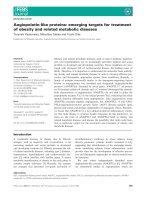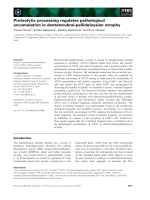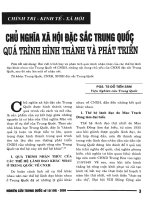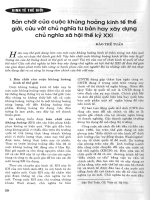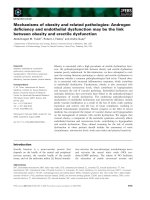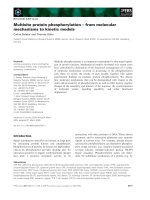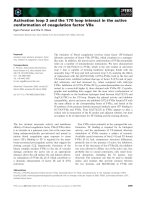Tài liệu Báo cáo khoa học: "Nonlinear Evidence Fusion and Propagation for Hyponymy Relation Mining" pdf
Bạn đang xem bản rút gọn của tài liệu. Xem và tải ngay bản đầy đủ của tài liệu tại đây (619.71 KB, 10 trang )
Proceedings of the 49th Annual Meeting of the Association for Computational Linguistics, pages 1159–1168,
Portland, Oregon, June 19-24, 2011.
c
2011 Association for Computational Linguistics
Nonlinear Evidence Fusion and Propagation
for Hyponymy Relation Mining
Fan Zhang
2*
Shuming Shi
1
Jing Liu
2
Shuqi Sun
3*
Chin-Yew Lin
1
1
Microsoft Research Asia
2
Nankai University, China
3
Harbin Institute of Technology, China
{shumings, cyl}@microsoft.com
Abstract
This paper focuses on mining the hypon-
ymy (or is-a) relation from large-scale,
open-domain web documents. A nonlinear
probabilistic model is exploited to model
the correlation between sentences in the
aggregation of pattern matching results.
Based on the model, we design a set of ev-
idence combination and propagation algo-
rithms. These significantly improve the
result quality of existing approaches. Ex-
perimental results conducted on 500 mil-
lion web pages and hypernym labels for
300 terms show over 20% performance
improvement in terms of P@5, MAP and
R-Precision.
1 Introduction
1
An important task in text mining is the automatic
extraction of entities and their lexical relations; this
has wide applications in natural language pro-
cessing and web search. This paper focuses on
mining the hyponymy (or is-a) relation from large-
scale, open-domain web documents. From the
viewpoint of entity classification, the problem is to
automatically assign fine-grained class labels to
terms.
There have been a number of approaches
(Hearst 1992; Pantel & Ravichandran 2004; Snow
et al., 2005; Durme & Pasca, 2008; Talukdar et al.,
2008) to address the problem. These methods typi-
cally exploited manually-designed or automatical-
*
This work was performed when Fan Zhang and Shuqi Sun
were interns at Microsoft Research Asia
ly-learned patterns (e.g., “NP such as NP”, “NP
like NP”, “NP is a NP”). Although some degree of
success has been achieved with these efforts, the
results are still far from perfect, in terms of both
recall and precision. As will be demonstrated in
this paper, even by processing a large corpus of
500 million web pages with the most popular pat-
terns, we are not able to extract correct labels for
many (especially rare) entities. Even for popular
terms, incorrect results often appear in their label
lists.
The basic philosophy in existing hyponymy ex-
traction approaches (and also many other text-
mining methods) is counting: count the number of
supporting sentences. Here a supporting sentence
of a term-label pair is a sentence from which the
pair can be extracted via an extraction pattern. We
demonstrate that the specific way of counting has a
great impact on result quality, and that the state-of-
the-art counting methods are not optimal. Specifi-
cally, we examine the problem from the viewpoint
of probabilistic evidence combination and find that
the probabilistic assumption behind simple count-
ing is the statistical independence between the ob-
servations of supporting sentences. By assuming a
positive correlation between supporting sentence
observations and adopting properly designed non-
linear combination functions, the results precision
can be improved.
It is hard to extract correct labels for rare terms
from a web corpus due to the data sparseness prob-
lem. To address this issue, we propose an evidence
propagation algorithm motivated by the observa-
tion that similar terms tend to share common hy-
pernyms. For example, if we already know that 1)
Helsinki and Tampere are cities, and 2) Porvoo is
similar to Helsinki and Tampere, then Porvoo is
1159
very likely also a city. This intuition, however,
does not mean that the labels of a term can always
be transferred to its similar terms. For example,
Mount Vesuvius and Kilimanjaro are volcanoes
and Lhotse is similar to them, but Lhotse is not a
volcano. Therefore we should be very conservative
and careful in hypernym propagation. In our prop-
agation algorithm, we first construct some pseudo
supporting sentences for a term from the support-
ing sentences of its similar terms. Then we calcu-
late label scores for terms by performing nonlinear
evidence combination based on the (pseudo and
real) supporting sentences. Such a nonlinear prop-
agation algorithm is demonstrated to perform bet-
ter than linear propagation.
Experimental results on a publicly available col-
lection of 500 million web pages with hypernym
labels annotated for 300 terms show that our non-
linear evidence fusion and propagation significant-
ly improve the precision and coverage of the
extracted hyponymy data. This is one of the tech-
nologies adopted in our semantic search and min-
ing system NeedleSeek
2
.
In the next section, we discuss major related ef-
forts and how they differ from our work. Section 3
is a brief description of the baseline approach. The
probabilistic evidence combination model that we
exploited is introduced in Section 4. Our main ap-
proach is illustrated in Section 5. Section 6 shows
our experimental settings and results. Finally, Sec-
tion 7 concludes this paper.
2 Related Work
Existing efforts for hyponymy relation extraction
have been conducted upon various types of data
sources, including plain-text corpora (Hearst 1992;
Pantel & Ravichandran, 2004; Snow et al., 2005;
Snow et al., 2006; Banko, et al., 2007; Durme &
Pasca, 2008; Talukdar et al., 2008), semi-
structured web pages (Cafarella et al., 2008; Shin-
zato & Torisawa, 2004), web search results (Geraci
et al., 2006; Kozareva et al., 2008; Wang & Cohen,
2009), and query logs (Pasca 2010). Our target for
optimization in this paper is the approaches that
use lexico-syntactic patterns to extract hyponymy
relations from plain-text corpora. Our future work
will study the application of the proposed algo-
rithms on other types of approaches.
2
or
The probabilistic evidence combination model
that we exploit here was first proposed in (Shi et
al., 2009), for combining the page in-link evidence
in building a nonlinear static-rank computation
algorithm. We applied it to the hyponymy extrac-
tion problem because the model takes the depend-
ency between supporting sentences into
consideration and the resultant evidence fusion
formulas are quite simple. In (Snow et al., 2006), a
probabilistic model was adopted to combine evi-
dence from heterogeneous relationships to jointly
optimize the relationships. The independence of
evidence was assumed in their model. In compari-
son, we show that better results will be obtained if
the evidence correlation is modeled appropriately.
Our evidence propagation is basically about us-
ing term similarity information to help instance
labeling. There have been several approaches
which improve hyponymy extraction with instance
clusters built by distributional similarity. In (Pantel
& Ravichandran, 2004), labels were assigned to
the committee (i.e., representative members) of a
semantic class and used as the hypernyms of the
whole class. Labels generated by their approach
tend to be rather coarse-grained, excluding the pos-
sibility of a term having its private labels (consid-
ering the case that one meaning of a term is not
covered by the input semantic classes). In contrast
to their method, our label scoring and ranking ap-
proach is applied to every single term rather than a
semantic class. In addition, we also compute label
scores in a nonlinear way, which improves results
quality. In Snow et al. (2005), a supervised ap-
proach was proposed to improve hypernym classi-
fication using coordinate terms. In comparison, our
approach is unsupervised. Durme & Pasca (2008)
cleaned the set of instance-label pairs with a
TF*IDF like method, by exploiting clusters of se-
mantically related phrases. The core idea is to keep
a term-label pair (T, L) only if the number of terms
having the label L in the term T’s cluster is above a
threshold and if L is not the label of too many clus-
ters (otherwise the pair will be discarded). In con-
trast, we are able to add new (high-quality) labels
for a term with our evidence propagation method.
On the other hand, low quality labels get smaller
score gains via propagation and are ranked lower.
Label propagation is performed in (Talukdar et
al., 2008; Talukdar & Pereira, 2010) based on mul-
tiple instance-label graphs. Term similarity infor-
mation was not used in their approach.
1160
Most existing work tends to utilize small-scale
or private corpora, whereas the corpus that we used
is publicly available and much larger than most of
the existing work. We published our term sets (re-
fer to Section 6.1) and their corresponding user
judgments so researchers working on similar topics
can reproduce our results.
Type
Pattern
Hearst-I
NP
L
{,} (such as) {NP,}
*
{and|or} NP
Hearst-II
NP
L
{,} (include(s) | including) {NP,}
*
{and|or} NP
Hearst-III
NP
L
{,} (e.g.|e.g) {NP,}
*
{and|or} NP
IsA-I
NP (is|are|was|were|being) (a|an) NP
L
IsA-II
NP (is|are|was|were|being) {the, those} NP
L
IsA-III
NP (is|are|was|were|being) {another, any} NP
L
Table 1. Patterns adopted in this paper (NP: named
phrase representing an entity; NP
L
: label)
3 Preliminaries
The problem addressed in this paper is corpus-
based is-a relation mining: extracting hypernyms
(as labels) for entities from a large-scale, open-
domain document corpus. The desired output is a
mapping from terms to their corresponding hyper-
nyms, which can naturally be represented as a
weighted bipartite graph (term-label graph). Typi-
cally we are only interested in top labels of a term
in the graph.
Following existing efforts, we adopt pattern-
matching as a basic way of extracting hyper-
nymy/hyponymy relations. Two types of patterns
(refer to Table 1) are employed, including the pop-
ular “Hearst patterns” (Hearst, 1992) and the IsA
patterns which are exploited less frequently in ex-
isting hyponym mining efforts. One or more term-
label pairs can be extracted if a pattern matches a
sentence. In the baseline approach, the weight of
an edge TL (from term T to hypernym label L) in
the term-label graph is computed as,
w(TL)
(3.1)
where m is the number of times the pair (T, L) is
extracted from the corpus, DF(L) is the number of
in-links of L in the graph, N is total number of
terms in the graph, and IDF means the “inverse
document frequency”.
A term can only keep its top-k neighbors (ac-
cording to the edge weight) in the graph as its final
labels.
Our pattern matching algorithm implemented in
this paper uses part-of-speech (POS) tagging in-
formation, without adopting a parser or a chunker.
The noun phrase boundaries (for terms and labels)
are determined by a manually designed POS tag
list.
4 Probabilistic Label-Scoring Model
Here we model the hyponymy extraction problem
from the probability theory point of view, aiming
at estimating the score of a term-label pair (i.e., the
score of a label w.r.t. a term) with probabilistic
evidence combination. The model was studied in
(Shi et al., 2009) to combine the page in-link evi-
dence in building a nonlinear static-rank computa-
tion algorithm.
We represent the score of a term-label pair by
the probability of the label being a correct hyper-
nym of the term, and define the following events,
A
T,L
: Label L is a hypernym of term T (the ab-
breviated form A is used in this paper unless it is
ambiguous).
E
i
: The observation that (T, L) is extracted from
a sentence S
i
via pattern matching (i.e., S
i
is a sup-
porting sentence of the pair).
Assuming that we already know m supporting
sentences (S
1
~S
m
), our problem is to compute
P(A|E
1
,E
2
, ,E
m
), the posterior probability that L is
a hypernym of term T, given evidence E
1
~E
m
.
Formally, we need to find a function f to satisfy,
P(A|E
1
,…,E
m
) = f(P(A), P(A|E
1
)…, P(A|E
m
) )
(4.1)
For simplicity, we first consider the case of
m=2. The case of m>2 is quite similar.
We start from the simple case of independent
supporting sentences. That is,
(4.2)
(4.3)
By applying Bayes rule, we get,
(4.4)
Then define
1161
Here G(A|E) represents the log-probability-gain
of A given E, with the meaning of the gain in the
log-probability value of A after the evidence E is
observed (or known). It is a measure of the impact
of evidence E to the probability of event A. With
the definition of G(A|E), Formula 4.4 can be trans-
formed to,
(4.5)
Therefore, if E
1
and E
2
are independent, the log-
probability-gain of A given both pieces of evidence
will exactly be the sum of the gains of A given eve-
ry single piece of evidence respectively. It is easy
to prove (by following a similar procedure) that the
above Formula holds for the case of m>2, as long
as the pieces of evidence are mutually independent.
Therefore for a term-label pair with m mutually
independent supporting sentences, if we set every
gain G(A|E
i
) to be a constant value g, the posterior
gain score of the pair will be
. If the
value g is the IDF of label L, the posterior gain will
be,
G(A
T,L
|E
1
…,E
m
)
(4.6)
This is exactly the Formula 3.1. By this way, we
provide a probabilistic explanation of scoring the
candidate labels for a term via simple counting.
Hearst-I
IsA-I
E
1
: Hearst-I
E
2
: IsA-I
R
A
:
66.87
17.30
24.38
R:
5997
1711
802.7
R
A
/R
0.011
0.010
0.030
Table 2. Evidence dependency estimation for intra-
pattern and inter-pattern supporting sentences
In the above analysis, we assume the statistical
independence of the supporting sentence observa-
tions, which may not hold in reality. Intuitively, if
we already know one supporting sentence S
1
for a
term-label pair (T, L), then we have more chance to
find another supporting sentence than if we do not
know S
1
. The reason is that, before we find S
1
, we
have to estimate the probability with the chance of
discovering a supporting sentence for a random
term-label pair. The probability is quite low be-
cause most term-label pairs do not have hyponymy
relations. Once we have observed S
1
, however, the
chance of (T, L) having a hyponymy relation in-
creases. Therefore the chance of observing another
supporting sentence becomes larger than before.
Table 2 shows the rough estimation of
(denoted as R
A
),
(denoted
as R), and their ratios. The statistics are obtained
by performing maximal likelihood estimation
(MLE) upon our corpus and a random selection of
term-label pairs from our term sets (see Section
6.1) together with their top labels
3
. The data veri-
fies our analysis about the correlation between E
1
and E
2
(note that R=1 means independent). In addi-
tion, it can be seen that the conditional independ-
ence assumption of Formula 4.3 does not hold
(because R
A
>1). It is hence necessary to consider
the correlation between supporting sentences in the
model. The estimation of Table 2 also indicates
that,
(4.7)
By following a similar procedure as above, with
Formulas 4.2 and 4.3 replaced by 4.7, we have,
(4.8)
This formula indicates that when the supporting
sentences are positively correlated, the posterior
score of label L w.r.t. term T (given both the sen-
tences) is smaller than the sum of the gains caused
by one sentence only. In the extreme case that sen-
tence S
2
fully depends on E
1
(i.e. P(E
2
|E
1
)=1), it is
easy to prove that
It is reasonable, since event E
2
does not bring in
more information than E
1
.
Formula 4.8 cannot be used directly for compu-
ting the posterior gain. What we really need is a
function h satisfying
(4.9)
and
(4.10)
Shi et al. (2009) discussed other constraints to h
and suggested the following nonlinear functions,
(4.11)
3
R
A
is estimated from the labels judged as “Good”; whereas
the estimation of R is from all judged labels.
1162
(p>1)
(4.12)
In the next section, we use the above two h func-
tions as basic building blocks to compute label
scores for terms.
5 Our Approach
Multiple types of patterns (Table 1) can be adopted
to extract term-label pairs. For two supporting sen-
tences the correlation between them may depend
on whether they correspond to the same pattern. In
Section 5.1, our nonlinear evidence fusion formu-
las are constructed by making specific assumptions
about the correlation between intra-pattern sup-
porting sentences and inter-pattern ones.
Then in Section 5.2, we introduce our evidence
propagation technique in which the evidence of a
(T, L) pair is propagated to the terms similar to T.
5.1 Nonlinear evidence fusion
For a term-label pair (T, L), assuming K patterns
are used for hyponymy extraction and the support-
ing sentences discovered with pattern i are,
(5.1)
where m
i
is the number of supporting sentences
corresponding to pattern i. Also assume the gain
score of S
i,j
is x
i,j
, i.e., x
i,j
=G(A|S
i,j
).
Generally speaking, supporting sentences corre-
sponding to the same pattern typically have a high-
er correlation than the sentences corresponding to
different patterns. This can be verified by the data
in Table-2. By ignoring the inter-pattern correla-
tions, we make the following simplified assump-
tion:
Assumption: Supporting sentences correspond-
ing to the same pattern are correlated, while those
of different patterns are independent.
According to this assumption, our label-scoring
function is,
(5.2)
In the simple case that
, if the h
function of Formula 4.12 is adopted, then,
(5.3)
We use an example to illustrate the above for-
mula.
Example: For term T and label L
1
, assume the
numbers of the supporting sentences corresponding
to the six pattern types in Table 1 are (4, 4, 4, 4, 4,
4), which means the number of supporting sen-
tences discovered by each pattern type is 4. Also
assume the supporting-sentence-count vector of
label L
2
is (25, 0, 0, 0, 0, 0). If we use Formula 5.3
to compute the scores of L
1
and L
2
, we can have
the following (ignoring IDF for simplicity),
Score(L
1
)
; Score(L
2
)
One the other hand, if we simply count the total
number of supporting sentences, the score of L
2
will be larger.
The rationale implied in the formula is: For a
given term T, the labels supported by multiple
types of patterns tend to be more reliable than
those supported by a single pattern type, if they
have the same number of supporting sentences.
5.2 Evidence propagation
According to the evidence fusion algorithm de-
scribed above, in order to extract term labels relia-
bly, it is desirable to have many supporting
sentences of different types. This is a big challenge
for rare terms, due to their low frequency in sen-
tences (and even lower frequency in supporting
sentences because not all occurrences can be cov-
ered by patterns). With evidence propagation, we
aim at discovering more supporting sentences for
terms (especially rare terms). Evidence propaga-
tion is motivated by the following two observa-
tions:
(I) Similar entities or coordinate terms tend to
share some common hypernyms.
(II) Large term similarity graphs are able to be
built efficiently with state-of-the-art techniques
(Agirre et al., 2009; Pantel et al., 2009; Shi et al.,
2010). With the graphs, we can obtain the similari-
ty between two terms without their hypernyms be-
ing available.
The first observation motivates us to “borrow”
the supporting sentences from other terms as auxil-
iary evidence of the term. The second observation
means that new information is brought with the
state-of-the-art term similarity graphs (in addition
to the term-label information discovered with the
patterns of Table 1).
1163
Our evidence propagation algorithm contains
two phases. In phase I, some pseudo supporting
sentences are constructed for a term from the sup-
porting sentences of its neighbors in the similarity
graph. Then we calculate the label scores for terms
based on their (pseudo and real) supporting sen-
tences.
Phase I: For every supporting sentence S and
every similar term T
1
of the term T, add a pseudo
supporting sentence S
1
for T
1
, with the gain score,
(5.5)
where is the propagation factor, and
is the term similarity function taking val-
ues in [0, 1]. The formula reasonably assumes that
the gain score of the pseudo supporting sentence
depends on the gain score of the original real sup-
porting sentence, the similarity between the two
terms, and the propagation factor.
Phase II: The nonlinear evidence combination
formulas in the previous subsection are adopted to
combine the evidence of pseudo supporting sen-
tences.
Term similarity graphs can be obtained by dis-
tributional similarity or patterns (Agirre et al.,
2009; Pantel et al., 2009; Shi et al., 2010). We call
the first type of graph DS and the second type PB.
DS approaches are based on the distributional hy-
pothesis (Harris, 1985), which says that terms ap-
pearing in analogous contexts tend to be similar. In
a DS approach, a term is represented by a feature
vector, with each feature corresponding to a con-
text in which the term appears. The similarity be-
tween two terms is computed as the similarity
between their corresponding feature vectors. In PB
approaches, a list of carefully-designed (or auto-
matically learned) patterns is exploited and applied
to a text collection, with the hypothesis that the
terms extracted by applying each of the patterns to
a specific piece of text tend to be similar. Two cat-
egories of patterns have been studied in the litera-
ture (Heast 1992; Pasca 2004; Kozareva et al.,
2008; Zhang et al., 2009): sentence lexical patterns,
and HTML tag patterns. An example of sentence
lexical patterns is “T {, T}*{,} (and|or) T”. HTML
tag patterns include HTML tables, drop-down lists,
and other tag repeat patterns. In this paper, we
generate the DS and PB graphs by adopting the
best-performed methods studied in (Shi et al.,
2010). We will compare, by experiments, the prop-
agation performance of utilizing the two categories
of graphs, and also investigate the performance of
utilizing both graphs for evidence propagation.
6 Experiments
6.1 Experimental setup
Corpus We adopt a publicly available dataset in
our experiments: ClueWeb09
4
. This is a very large
dataset collected by Carnegie Mellon University in
early 2009 and has been used by several tracks of
the Text Retrieval Conference (TREC)
5
. The whole
dataset consists of 1.04 billion web pages in ten
languages while only those in English, about 500
million pages, are used in our experiments. The
reason for selecting such a dataset is twofold: First,
it is a corpus large enough for conducting web-
scale experiments and getting meaningful results.
Second, since it is publicly available, it is possible
for other researchers to reproduce the experiments
in this paper.
Term sets Approaches are evaluated by using
two sets of selected terms: Wiki200, and Ext100.
For every term in the term sets, each approach
generates a list of hypernym labels, which are
manually judged by human annotators. Wiki200 is
constructed by first randomly selecting 400 Wik-
ipedia
6
titles as our candidate terms, with the prob-
ability of a title T being selected to be
, where F(T) is the frequency of T in our data
corpus. The reason of adopting such a probability
formula is to balance popular terms and rare ones
in our term set. Then 200 terms are manually se-
lected from the 400 candidate terms, with the prin-
ciple of maximizing the diversity of terms in terms
of length (i.e., number of words) and type (person,
location, organization, software, movie, song, ani-
mal, plant, etc.). Wiki200 is further divided into
two subsets: Wiki100H and Wiki100L, containing
respectively the 100 high-frequency and low-
frequency terms. Ext100 is built by first selecting
200 non-Wikipedia-title terms at random from the
term-label graph generated by the baseline ap-
proach (Formula 3.1), then manually selecting 100
terms.
Some sample terms in the term sets are listed in
Table 3.
4
5
6
1164
Term
Set
Sample Terms
Wiki200
Canon EOS 400D, Disease management, El Sal-
vador, Excellus Blue Cross Blue Shield, F33,
Glasstron, Indium, Khandala, Kung Fu, Lake
Greenwood, Le Gris, Liriope, Lionel Barrymore,
Milk, Mount Alto, Northern Wei, Pink Lady,
Shawshank, The Dog Island, White flight, World
War II…
Ext100
A2B, Antique gold, GPTEngine, Jinjiang Inn,
Moyea SWF to Apple TV Converter, Nanny ser-
vice, Outdoor living, Plasmid DNA, Popon, Spam
detection, Taylor Ho Bynum, Villa Michelle…
Table 3. Sample terms in our term sets
Annotation For each term in the term set, the
top-5 results (i.e., hypernym labels) of various
methods are mixed and judged by human annota-
tors. Each annotator assigns each result item a
judgment of “Good”, “Fair” or “Bad”. The annota-
tors do not know the method by which a result item
is generated. Six annotators participated in the la-
beling with a rough speed of 15 minutes per term.
We also encourage the annotators to add new good
results which are not discovered by any method.
The term sets and their corresponding user anno-
tations are available for download at the following
links (dataset ID=data.queryset.semcat01):
Evaluation We adopt the following metrics to
evaluate the hypernym list of a term generated by
each method. The evaluation score on a term set is
the average over all the terms.
Precision@k: The percentage of relevant (good
or fair) labels in the top-k results (labels judged as
“Fair” are counted as 0.5)
Recall@k: The ratio of relevant labels in the top-
k results to the total number of relevant labels
R-Precision: Precision@R where R is the total
number of labels judged as “Good”
Mean average precision (MAP): The average of
precision values at the positions of all good or fair
results
Before annotation and evaluation, the hypernym
list generated by each method for each term is pre-
processed to remove duplicate items. Two hyper-
nyms are called duplicate items if they share the
same head word (e.g., “military conflict” and “con-
flict”). For duplicate hypernyms, only the first (i.e.,
the highest ranked one) in the list is kept. The goal
with such a preprocessing step is to partially con-
sider results diversity in evaluation and to make a
more meaningful comparison among different
methods. Consider two hypernym lists for “sub-
way”:
List-1: restaurant; chain restaurant; worldwide chain
restaurant; franchise; restaurant franchise…
List-2: restaurant; franchise; transportation; company;
fast food…
There are more detailed hypernyms in the first
list about “subway” as a restaurant or a franchise;
while the second list covers a broader range of
meanings for the term. It is hard to say which is
better (without considering the upper-layer appli-
cations). With this preprocessing step, we keep our
focus on short hypernyms rather than detailed ones.
Term Set
Method
MAP
R-Prec
P@1
P@5
Wiki200
Linear
0.357
0.376
0.783
0.547
Log
0.371
3.92%
0.384
2.13%
0.803
2.55%
0.561
2.56%
PNorm
0.372
4.20%
0.384
2.13%
0.800
2.17%
0.562
2.74%
Wiki100H
Linear
0.363
0.382
0.805
0.627
Log
0.393
8.26%
0.402
5.24%
0.845
4.97%
0.660
5.26%
PNorm
0.395
8.82%
0.403
5.50%
0.840
4.35%
0.662
5.28%
Table 4. Performance comparison among various
evidence fusion methods (Term sets: Wiki200 and
Wiki100H; p=2 for PNorm)
6.2 Experimental results
We first compare the evaluation results of different
evidence fusion methods mentioned in Section 4.1.
In Table 4, Linear means that Formula 3.1 is used
to calculate label scores, whereas Log and PNorm
represent our nonlinear approach with Formulas
4.11 and 4.12 being utilized. The performance im-
provement numbers shown in the table are based
on the linear version; and the upward pointing ar-
rows indicate relative percentage improvement
over the baseline. From the table, we can see that
the nonlinear methods outperform the linear ones
on the Wiki200 term set. It is interesting to note
that the performance improvement is more signifi-
cant on Wiki100H, the set of high frequency terms.
By examining the labels and supporting sentences
for the terms in each term set, we find that for
many low-frequency terms (in Wiki100L), there
are only a few supporting sentences (corresponding
1165
to one or two patterns). So the scores computed by
various fusion algorithms tend to be similar. In
contrast, more supporting sentences can be discov-
ered for high-frequency terms. Much information
is contained in the sentences about the hypernyms
of the high-frequency terms, but the linear function
of Formula 3.1 fails to make effective use of it.
The two nonlinear methods achieve better perfor-
mance by appropriately modeling the dependency
between supporting sentences and computing the
log-probability gain in a better way.
The comparison of the linear and nonlinear
methods on the Ext100 term set is shown in Table
5. Please note that the terms in Ext100 do not ap-
pear in Wikipedia titles. Thanks to the scale of the
data corpus we are using, even the baseline ap-
proach achieves reasonably good performance.
Please note that the terms (refer to Table 3) we are
using are “harder” than those adopted for evalua-
tion in many existing papers. Again, the results
quality is improved with the nonlinear methods,
although the performance improvement is not big
due to the reason that most terms in Ext100 are
rare. Please note that the recall (R@1, R@5) in this
paper is pseudo-recall, i.e., we treat the number of
known relevant (Good or Fair) results as the total
number of relevant ones.
Method
MAP
R-Prec
P@1
P@5
R@1
R@5
Linear
0.384
0.429
0.665
0.472
0.116
0.385
Log
0.395
0.429
0.715
0.472
0.125
0.385
2.86%
0%
7.52%
0%
7.76%
0%
PNorm
0.390
0.429
0.700
0.472
0.120
0.385
1.56%
0%
5.26%
0%
3.45%
0%
Table 5. Performance comparison among various
evidence fusion methods (Term set: Ext100; p=2
for PNorm)
The parameter p in the PNorm method is related
to the degree of correlations among supporting
sentences. The linear method of Formula 3.1 corre-
sponds to the special case of p=1; while p= rep-
resents the case that other supporting sentences are
fully correlated to the supporting sentence with the
maximal log-probability gain. Figure 1 shows that,
for most of the term sets, the best performance is
obtained for [2.0, 4.0]. The reason may be that
the sentence correlations are better estimated with
p values in this range.
Figure 1. Performance curves of PNorm with dif-
ferent parameter values (Measure: MAP)
The experimental results of evidence propaga-
tion are shown in Table 6. The methods for com-
parison are,
Base: The linear function without propagation.
NL: Nonlinear evidence fusion (PNorm with
p=2) without propagation.
LP: Linear propagation, i.e., the linear function
is used to combine the evidence of pseudo support-
ing sentences.
NLP: Nonlinear propagation where PNorm
(p=2) is used to combine the pseudo supporting
sentences.
NL+NLP: The nonlinear method is used to
combine both supporting sentences and pseudo
supporting sentences.
Method
MAP
R-Prec
P@1
P@5
R@5
Base
0.357
0.376
0.783
0.547
0.317
NL
0.372
0.384
0.800
0.562
0.325
4.20%
2.13%
2.17%
2.74%
2.52%
LP
0.357
0.376
0.783
0.547
0.317
0%
0%
0%
0%
0%
NLP
0.396
0.418
0.785
0.605
0.357
10.9%
11.2%
0.26%
10.6%
12.6%
NL+NLP
0.447
0.461
0.840
0.667
0.404
25.2%
22.6%
7.28%
21.9%
27.4%
Table 6. Evidence propagation results (Term set:
Wiki200; Similarity graph: PB; Nonlinear formula:
PNorm)
In this paper, we generate the DS (distributional
similarity) and PB (pattern-based) graphs by adopt-
ing the best-performed methods studied in (Shi et
al., 2010). The performance improvement numbers
(indicated by the upward pointing arrows) shown
in tables 6~9 are relative percentage improvement
1166
over the base approach (i.e., linear function with-
out propagation). The values of parameter are set
to maximize the MAP values.
Several observations can be made from Table 6.
First, no performance improvement can be ob-
tained with the linear propagation method (LP),
while the nonlinear propagation algorithm (NLP)
works quite well in improving both precision and
recall. The results demonstrate the high correlation
between pseudo supporting sentences and the great
potential of using term similarity to improve hy-
pernymy extraction. The second observation is that
the NL+NLP approach achieves a much larger per-
formance improvement than NL and NLP. Similar
results (omitted due to space limitation) can be
observed on the Ext100 term set.
Method
MAP
R-Prec
P@1
P@5
R@5
Base
0.357
0.376
0.783
0.547
0.317
NL+NLP
(PB)
0.415
0.439
0.830
0.633
0.379
16.2%
16.8%
6.00%
15.7%
19.6%
NL+NLP
(DS)
0.456
0.469
0.843
0.673
0.406
27.7%
24.7%
7.66%
23.0%
28.1%
NL+NLP
(PB+DS)
0.473
0.487
0.860
0.700
0.434
32.5%
29.5%
9.83%
28.0%
36.9%
Table 7. Combination of PB and DS graphs for
evidence propagation (Term set: Wiki200; Nonlin-
ear formula: Log)
Method
MAP
R-Prec
P@1
P@5
R@5
Base
0.351
0.370
0.760
0.467
0.317
NL+NLP
(PB)
0.411
0.448
0.770
0.564
0.401
↑17.1%
↑21.1%
↑1.32%
↑20.8%
↑26.5%
NL+NLP
(DS)
0.469
0.490
0.815
0.622
0.438
33.6%
32.4%
7.24%
33.2%
38.2%
NL+NLP
(PB+DS)
0.491
0.513
0.860
0.654
0.479
39.9%
38.6%
13.2%
40.0%
51.1%
Table 8. Combination of PB and DS graphs for
evidence propagation (Term set: Wiki100L)
Now let us study whether it is possible to com-
bine the PB and DS graphs to obtain better results.
As shown in Tables 7, 8, and 9 (for term sets
Wiki200, Wiki100L, and Ext100 respectively, us-
ing the Log formula for fusion and propagation),
utilizing both graphs really yields additional per-
formance gains. We explain this by the fact that the
information in the two term similarity graphs tends
to be complimentary. The performance improve-
ment over Wiki100L is especially remarkable. This
is reasonable because rare terms do not have ade-
quate information in their supporting sentences due
to data sparseness. As a result, they benefit the
most from the pseudo supporting sentences propa-
gated with the similarity graphs.
Method
MAP
R-Prec
P@1
P@5
R@5
Base
0.384
0.429
0.665
0.472
0.385
NL+NLP
(PB)
0.454
0.479
0.745
0.550
0.456
18.3%
11.7%
12.0%
16.5%
18.4%
NL+NLP
(DS)
0.404
0.441
0.720
0.486
0.402
5.18%
2.66%
8.27%
2.97%
4.37%
NL+NLP(P
B+DS)
0.483
0.518
0.760
0.586
0.492
26.0%
20.6%
14.3%
24.2%
27.6%
Table 9. Combination of PB and DS graphs for
evidence propagation (Term set: Ext100)
7 Conclusion
We demonstrated that the way of aggregating sup-
porting sentences has considerable impact on re-
sults quality of the hyponym extraction task using
lexico-syntactic patterns, and the widely-used
counting method is not optimal. We applied a se-
ries of nonlinear evidence fusion formulas to the
problem and saw noticeable performance im-
provement. The data quality is improved further
with the combination of nonlinear evidence fusion
and evidence propagation. We also introduced a
new evaluation corpus with annotated hypernym
labels for 300 terms, which were shared with the
research community.
Acknowledgments
We would like to thank Matt Callcut for reading
through the paper. Thanks to the annotators for
their efforts in judging the hypernym labels.
Thanks to Yueguo Chen, Siyu Lei, and the anony-
mous reviewers for their helpful comments and
suggestions. The first author is partially supported
by the NSF of China (60903028,61070014), and
Key Projects in the Tianjin Science and Technolo-
gy Pillar Program.
1167
References
E. Agirre, E. Alfonseca, K. Hall, J. Kravalova, M. Pas-
ca, and A. Soroa. 2009. A Study on Similarity and
Relatedness Using Distributional and WordNet-based
Approaches. In Proc. of NAACL-HLT’2009.
M. Banko, M.J. Cafarella, S. Soderland, M. Broadhead,
and O. Etzioni. 2007. Open Information Extraction
from the Web. In Proc. of IJCAI’2007.
M. Cafarella, A. Halevy, D. Wang, E. Wu, and Y.
Zhang. 2008. WebTables: Exploring the Power of
Tables on the Web. In Proceedings of the 34th Con-
ference on Very Large Data Bases (VLDB’2008),
pages 538–549, Auckland, New Zealand.
B. Van Durme and M. Pasca. 2008. Finding cars, god-
desses and enzymes: Parametrizable acquisition of
labeled instances for open-domain information ex-
traction. Twenty-Third AAAI Conference on Artifi-
cial Intelligence.
F. Geraci, M. Pellegrini, M. Maggini, and F. Sebastiani.
2006. Cluster Generation and Cluster Labelling for
Web Snippets: A Fast and Accurate Hierarchical So-
lution. In Proceedings of the 13th Conference on
String Processing and Information Retrieval
(SPIRE’2006), pages 25–36, Glasgow, Scotland.
Z. S. Harris. 1985. Distributional Structure. The Philos-
ophy of Linguistics. New York: Oxford University
Press.
M. Hearst. 1992. Automatic Acquisition of Hyponyms
from Large Text Corpora. In Fourteenth International
Conference on Computational Linguistics, Nantes,
France.
Z. Kozareva, E. Riloff, E.H. Hovy. 2008. Semantic
Class Learning from the Web with Hyponym Pattern
Linkage Graphs. In Proc. of ACL'2008.
P. Pantel, E. Crestan, A. Borkovsky, A M. Popescu and
V. Vyas. 2009. Web-Scale Distributional Similarity
and Entity Set Expansion. EMNLP’2009. Singapore.
P. Pantel and D. Ravichandran. 2004. Automatically
Labeling Semantic Classes. In Proc. of the 2004 Hu-
man Language Technology Conference (HLT-
NAACL’2004), 321–328.
M. Pasca. 2004. Acquisition of Categorized Named
Entities for Web Search. In Proc. of CIKM’2004.
M. Pasca. 2010. The Role of Queries in Ranking La-
beled Instances Extracted from Text. In Proc. of
COLING’2010, Beijing, China.
S. Shi, B. Lu, Y. Ma, and J R. Wen. 2009. Nonlinear
Static-Rank Computation. In Proc. of CIKM’2009,
Kong Kong.
S. Shi, H. Zhang, X. Yuan, J R. Wen. 2010. Corpus-
based Semantic Class Mining: Distributional vs. Pat-
tern-Based Approaches. In Proc. of COLING’2010,
Beijing, China.
K. Shinzato and K. Torisawa. 2004. Acquiring Hypon-
ymy Relations from Web Documents. In Proc. of the
2004 Human Language Technology Conference
(HLT-NAACL’2004).
R. Snow, D. Jurafsky, and A. Y. Ng. 2005. Learning
Syntactic Patterns for Automatic Hypernym Discov-
ery. In Proceedings of the 19th Conference on Neural
Information Processing Systems.
R. Snow, D. Jurafsky, and A. Y. Ng. 2006. Semantic
Taxonomy Induction from Heterogenous Evidence.
In Proceedings of the 21st International Conference
on Computational Linguistics and 44th Annual Meet-
ing of the Association for Computational Linguistics
(COLING-ACL-06), 801–808.
P. P. Talukdar and F. Pereira. 2010. Experiments in
Graph-based Semi-Supervised Learning Methods for
Class-Instance Acquisition. In 48th Annual Meeting
of the Association for Computational Linguistics
(ACL’2010).
P. P. Talukdar, J. Reisinger, M. Pasca, D. Ravichandran,
R. Bhagat, and F. Pereira. 2008. Weakly-Supervised
Acquisition of Labeled Class Instances using Graph
Random Walks. In Proceedings of the 2008 Confer-
ence on Empirical Methods in Natural Language
Processing (EMNLP’2008), pages 581–589.
R.C. Wang. W.W. Cohen. Automatic Set Instance Ex-
traction using the Web. In Proc. of the 47th Annual
Meeting of the Association for Computational Lin-
guistics (ACL-IJCNLP’2009), pages 441–449, Sin-
gapore.
H. Zhang, M. Zhu, S. Shi, and J R. Wen. 2009. Em-
ploying Topic Models for Pattern-based Semantic
Class Discovery. In Proc. of the 47th Annual Meet-
ing of the Association for Computational Linguistics
(ACL-IJCNLP’2009), pages 441–449, Singapore.
1168

